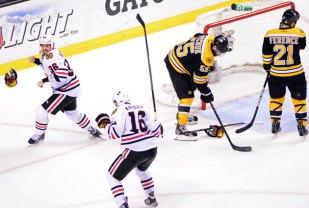With just 1:17 left in game six of the Stanley Cup Finals, a game seven appeared to be on the horizon.
Not so fast, Boston fans.
Trailing 2-1 (and leading 3-2 in the best-of-seven series), Blackhawks’ forward Bryan Bickell drove the puck past the glove side Boston’s highly-appraised goaltender, Tuukka Rask. With just a buck fifteen remaining in the game, the score now read 2-2. Overtime now materialized as a certainty.
Not so fast, lovers of “free hockey.”
Just 17 seconds later, Dave Bolland fired a Michael Frolik redirect into the back of the net. Soon after, he threw off his gloves as if the Blackhawks had just won the Stanley Cup, but there were still 58.3 seconds left on the game clock in Boston’s TD Garden.
No “not so fast” this time, because Bolland’s celebration was justified. The Blackhawks had just clinched their second Stanley Cup title in the previous four seasons.

Until the fat lady sings: Just 17 seconds earlier, a game seven seemed certain, but Dave Bolland (36 in white) reminded us all that, as Yogi Berra once said, “it ain’t over until it’s over.”
Clearly, this game six showed all of America how hockey play always stick the mantras, “never give up,” and “it ain’t over ’till it’s over.” Applying this label of perseverance to hockey players is supported by two comeback victories during this postseason: The Bruins’ recovered after trailing Toronto by three goals to win game seven of their round-one matchup and the Blackhawks’ claimed a series victory over hated rival Detroit, winning the series in seven games after trailing three games to one.
In other sports, coaches and players often throw in the metaphorical white flag before the sounding of the final buzzer. Look at game 3 of the NBA Finals: With his team being pounded by the Spurs in San Antonio, Heat coach Erik Spoelstra pulled his starters, essentially giving up. While the format of hockey rosters doesn’t allow a coach to “pull his starters,” any sort of giving up is intolerable throughout this great sport. That is one thing that makes the game and its players so unique.
In contrast to hockey, petty injuries often cause players in other sports to miss games: “Cracked skin in right thumb” (Tigers’ pitcher Justin Verlander on 4/25) and “Sensitivity after tattoo application” (Rangers’ infielder Elvis Andrus on 2/28) are two examples in Major League Baseball.
Now, imagine this: Boston bruiser Zdeno Chara leaving the game with “cracked skin” in his thumb. Imagine Anaheim and Philadelphia great Chris Pronger missing action with “soreness from a tattoo.” If you are going to great pains just to imagine these blasphemies, you’re not alone. There’s a simple reason why we can’t imagine these: Hockey players are some tough dudes.
Here are some examples of bearded Bruin warriors who gave it a go in game six, despite injuries that would end most athletes’ season:
- Boston’s Patrice Bergeron amassed 17:45 of ice time in game six despite suffering from a punctured lung, broken rib, separated shoulder and torn cartilage and muscles in his ribs. Bergeron later summed up his resilience like a true hockey player, telling Yahoo! Sports, “It’s the Stanley Cup Final, everyone’s banged up, everyone wants to help the team.”
- Bruins’ winger Nathan Horton played games two through six with a severe shoulder injury sustained in game one.
- Zdeno Chara, who was on the ice for 10 of Chicago’s final 12 goals of the series, and Jaromir Jagr both dealt with “undisclosed” injuries, but persevered, maintaining presence for a combined 39 shifts in game six.
On the Chicago side, the roses were no redder:
- 36-year-old Michal Handzus played the series despite suffering from a broken wrist (how does one lift the 35-pound Stanley Cup with a broken wrist?) and a torn MCL (Bears’ fans might remember Jay Cutler leaving the 2011 NFC Championship Game with a sprained MCL).
- Marian Hossa endured a pinch nerve in his back that led to his loss of feeling in his right foot, and played in games four, five and six with his injury.
- Andrew Shaw, who scored the game-winner in the Cup Final’s epic triple-overtime thriller, suffered a broken rib in the Western Conference Semifinals vs. Detroit.
- Captain Jonathan Toews recorded two points in 20:12 of ice time after “getting his bell rung” by Bruins defenseman Johnny Boychuck in game five. Toews: “We had guys willing to do whatever it took.”
- Bickell, who also showcased a gaping hole where his front teeth once were after enduring a puck to the face, suffered from a grade-two knee sprain sustained in the Western Conference Finals against the defending-champion Kings.
The never-ending catalog of injuries encountered in these Stanley Cup Finals proves that hockey players are some of the most relentless, toughest athletes on planet Earth. Especially in the playoffs, the prototypical image of a hockey player is a crazy-eyed, bearded dude with two black eyes, five missing teeth, and stitches on his chin. Blackhawks’ forward Andrew Shaw epitomized this image in game six. In the first period, Shaw (who was suffering from a broken rib at the time!) took a Shawn Thornton slapshot to the face. The blood dripping on the ice and streaming onto his sweater was unavoidable, but just a few minutes later, Shaw was back on the attack with stitches sealing up his swollen right cheek. Shaw would continue to bleed throughout the game, often forced to clean up on the bench in order to return. He fought, refusing to leave the game, a decision Shaw later coined as “worth all the stitches.” The lasting image of Shaw’s game six is his lifting of the Stanley Cup, looking up at the gleaming silver barrel with blood streaming down his considerably swollen right cheek.

No glitz, no glamour: Lifting Lord Stanley’s Cup over his head as blood streamed down his cheek, Andrew Shaw showed us the determined heart of a hockey player. (Click on image to enlarge)
Featuring its wide array of injuries, the starting lineups of game six resembled an MLB disabled list and even an NFL physically unable to perform list, which indeed demonstrates the innate toughness of hockey players. They refuse to use injury as an excuse, embracing the image of bearded, battered warriors; they never give up on a game, even if it seems like a lost cause. Considering its array of injuries and stunning comeback, game six of these Stanley Cup Finals embodied all of this, and showed fans all over the world the beauty of the wonderful, not-so-glamorous sport of hockey.
By Sam Brief
Feel free to leave a comment below! Your opinion is always welcome.
Sam’s Sports Brief is on Twitter! Follow @SamsSportsBrief for even more insight and opinion.
(Related: Cup heads West to Chicago)
<a href="http://polldaddy.com/poll/7204560">Take Our Poll</a>